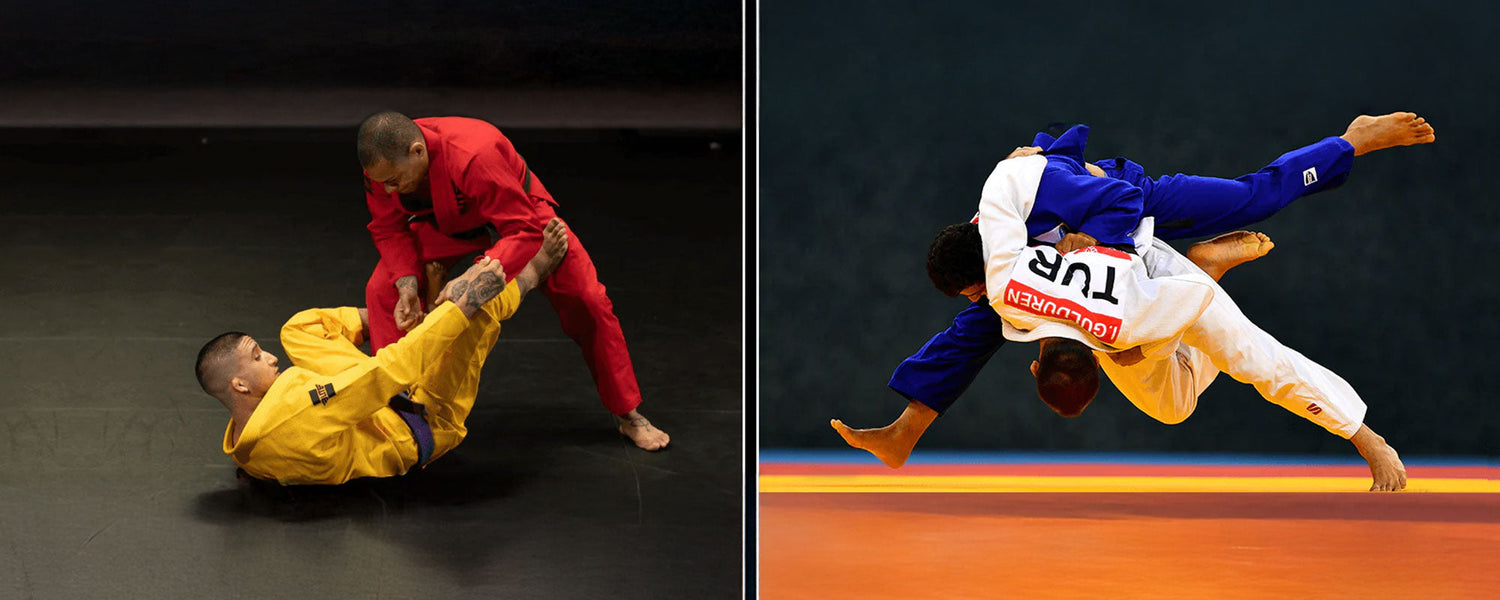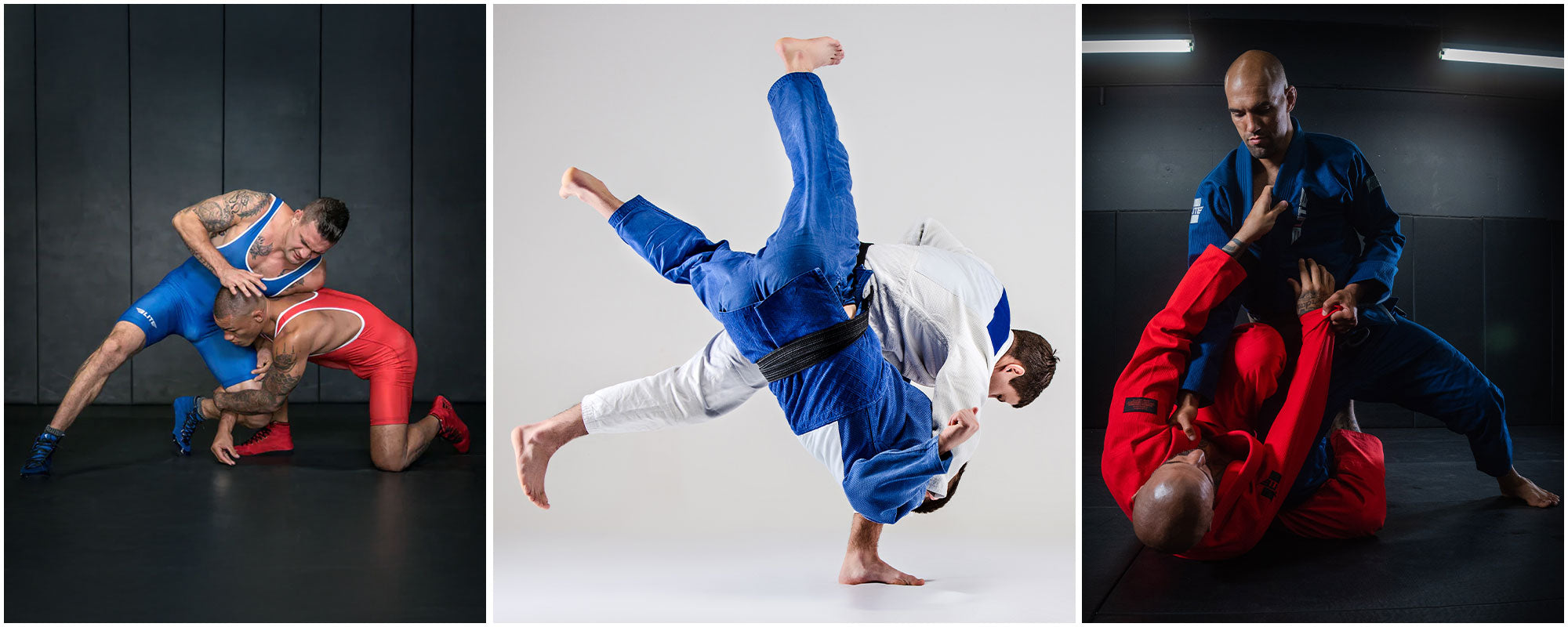Table of content
1. How Similar/Different Are BJJ And Judo?
In 1882, Jigoro Kano created judo as a form of self-defense. The objective of judo is to throw the opponent, pin the joints, and subdue the opponent. Judo drew inspiration from jiu-jitsu, basing many of its techniques and fighting styles on it. A significant change in judo occurred in 1964 during the Olympic Games.
In 1920, the Gracie brothers created BJJ in Brazil based on aspects of judo taught by Mitsuyo Maeda. BJJ gained popularity in 1990 after BJJ fighters defeated fighters from other disciplines in the Ultimate Fighting Championship.
Because both martial arts focus on grappling yet have very diverse origins, there is much debate about whether judo and BJJ are alike or different. Many studies have explored the characteristics of judo and BJJ such as techniques, belt systems, and as a form of self-defense. Research has shown that 92% of judo and BJJ’s rules, techniques, etc. are practically the same. However, judo involves grappling with an emphasis on fighting while standing up while BJJ focuses on fighting on the ground fighting.
See Also: Participants in BJJ & Judo
2. Similarities Between BJJ And Judo
Both BJJ and Judo are termed as gentle, while in translating to Judo means gentle way and the BJJ implies gentle art. Although and share similar techniques such as throws and chokes that can subdue opponents without causing severe injuries. The core similarities between these two martial arts are the use of a gi, techniques, and belt systems. Gi’s is the traditional uniform used in BJJ and judo. UFC allows blue, black, and white gis for BJJ while only the white gi is used for judo. Both judo and BJJ were created to be reliable forms of self-defense against larger opponents. Though sharing similar lists of techniques like chokeholds and joint locks, BJJ allows takedowns while Judo does not.
| Judo | BJJ | |
|---|---|---|
| Gi | White | White Blue Black |
| Similar Techniques | Chokeholds Joint locks Grappling |
Chokeholds Joint locks Grappling |
| Structures | Allows a smaller weaker person to defeat larger opponents Means of self-defense |
Allows smaller fighters to defeat larger opponents Means of self-defense |
| Belt | 5- to reach black belt | 8-12 to reach black belt |
2.1. Rules of BJJ And Judo
BJJ and Judo share similar rules as you win a match by pulling off a submission or earning more points than the opponent. BJJ and Judo have the same techniques but the difference in emphasis is apparent. Judo and BJJ share the same techniques and principles with each other. There is evidently a difference in the philosophy of both games but in training, it is hard-pressed to pinpoint the difference.
Judo Rules
- Judo practitioners step on the mat and bow before practicing or competing.
- Judo practitioners must wear a proper gi and belt.
- Judo has a scoring system where three types of points are awarded: Ippon, Waza-ari, and Yuko for immobilizing and throwing an opponent.
- Similarly, Shido and Hansoku are handed out for any minor and major penalties respectively.
BJJ Rules
- BJJ fighters step on the mat and bow before practicing or competing.
- The fighter with more points wins if no one taps out or submits.
- Points are awarded to athletes for getting into dominant positions.
- BJJ focuses on ground fighting and has fewer throws, but is able to subdue an opponent with minimal injury.
2.2. Structure of BJJ And Judo
Judo throws at BJJ the athlete being thrown has normally the old-style upright judo posture. This structure for these two games has many similarities. BJJ does offer 3 years of kids’ training. The similarity can be summed up by their nickname gentle ways or gentle art. Gi structure for both martial art sports share some similarities. Gi structure looks similar for both sports at first glance.
Judo and BJJ Structure
| Age | Weight | |
|---|---|---|
| Juniors | 14 to 20 | 44 to 78 for women 55 to 100+ for men |
| Seniors | 16+ | 48 to 78+ for women 60 to 100+ for men |
| Masters | 30+ | 48 to 78+ for women 60 to 100+ for men |
2.3. Roots of BJJ And Judo
Both judo and BJJ draw their roots from the Japanese culture, being inspired by jiu-jitsu techniques practiced by samurai. Both martial arts try to put an opponent off-balance by turning the opponent’s strength, size, or aggression against them. Throwing an opponent off-balance, as well as using hip throws, joint locks, and choke holds are both aspects of BJJ and judo. Judo was developed from different styles of jiu-jitsu, focusing more on grappling techniques. Judo teaches you how to escape an opponent’s hold and counter any grappling techniques. Meanwhile, BJJ came from Mitsuyo Maeda’s style of judo which focused on overcoming opponents twice your size. BJJ focuses more on ground fighting, teaching you to control your opponent’s movements and execute a submission hold. Both martial arts do not include the use of strikes.
2.4. Rolling and Sparring
Grappling martial arts require practitioners to hone their skills by sparring or rolling. Judo has one-on-one live sparring and free-style practice known as randori. Sparring is a way to improve your fighting skills against a practice opponent. This type of training is less repetitive than drills, exposes you to new fighting styles, and requires you to be in full contact with other practitioners.
In contrast to other martial arts, both BJJ and judo not allowing striking or the use of weapons makes sparring safer and can be done almost anywhere at any time.
2.5. Judo And BJJ as Self-Defense
While judo and BJJ are often used in training and competitions, they are both useful as means of self-defense. Both disciplines have techniques that can be executed on the streets, serving as countermeasures against bullies and attackers.
See Also: Self-Defense
3. Differences Between BJJ And Judo
Judo and Brazilian Jiu-Jitsu seem to share more similarities than differences, however, there are certain aspects where they are not exactly alike. The differences between judo and BJJ are listed below:
| Sr. # | Judo | BJJ |
|---|---|---|
| 1 | Judo focuses on grapples and throws. | BJJ emphasizes ground fighting. |
| 2 | Judo originated in Japan and is derived from jiu-jitsu. | BJJ originated in Brazil and is derived from judo. |
| 3 | Judo matches can be won by throws. | BJJ awards points for throws. |
| 4 | Judo matches do not need to be initiated by throws. | BJJ matches start after throwing. |
| 5 | Judo gi is heavier and fits loosely on the body. | BJJ gi is tight fitting around the body. |
4. Similar Start, But Different Directions
Understanding what makes judo and BJJ different can help one become a better martial artist. Although BJJ is more popular today, judo has also evolved a lot as a sport throughout history. Most of the techniques in these sports depend on the strength of your grip and how well you can immobilize your opponent.
5. Conclusion
Brazilian Jiu-Jitsu resembles judo more so than any other martial art, but they are not exact copies of each other. Both judo and BJJ are considered gentle arts as they teach athletes to take down an opponent with minimal damage. Throws are more difficult to pull off in judo, but BJJ encourages throws to help you take opponents off guard and control their movements. BJJ and judo both became mainstream martial arts due to their rising popularity and inclusion in competitions.
Photo Credit: @pxfuel












Leave a comment
This site is protected by hCaptcha and the hCaptcha Privacy Policy and Terms of Service apply.